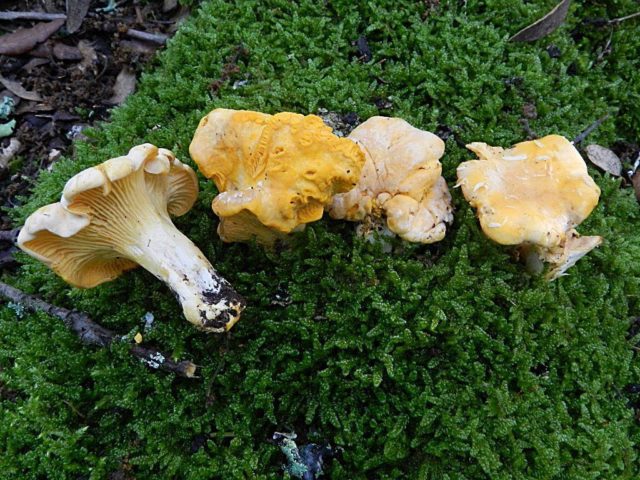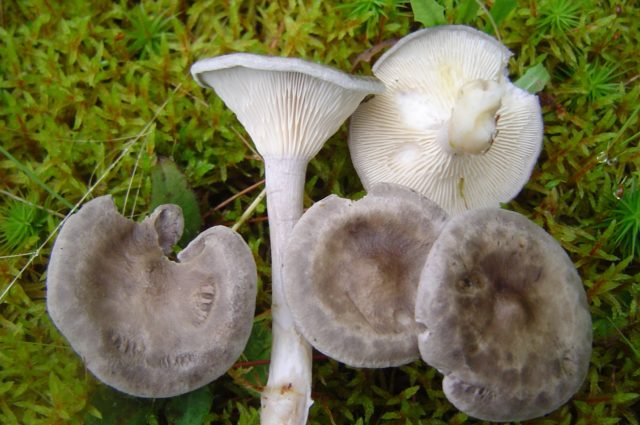Content
- 1 Where do white chanterelles grow
- 2 What do chanterelles look like in white
- 3 Is it possible to eat white chanterelles
- 4 Taste qualities of white chanterelles
- 5 The benefits and harms of white chanterelles
- 6 Collection rules
- 7 False doubles of white chanterelles
- 8 The use of white chanterelles
- 9 Conclusion
Chanterelles are often harvested throughout the season. They are tasty, edible, and bring many benefits to the body. It is very easy to distinguish them from other species and false mushrooms.
Where do white chanterelles grow
Most often they are found in coniferous or deciduous forests, where there is high humidity. They prefer to grow in coniferous or leaf litter. However, a mushroom clearing can also be found near a rotted tree, in moss. White chanterelles are also common in birch groves, where the local climate is suitable for their growth.
What do chanterelles look like in white
The white or pale chanterelle mushroom belongs to the Chanterelle family. The photo shows that this is a kind of yellow chanterelle.
A distinctive feature of the white chanterelle is the hat. It is wavy, has uneven edges, funnel-shaped. Although these differences do not appear immediately. Next to adult mushrooms, you can see young fruiting bodies, whose caps are completely even. Gradually they curl upward. The diameter of the cap reaches 1-5 cm, but when weather conditions are favorable, specimens up to 8 cm in diameter can be found. The color of the fruit body is uniform, from pale yellow to fawn.
The leg of a real white chanterelle is thick, cream or pale yellow in color. Its thickness is in the range of 0.5-1.5 cm. The length of the leg is up to 2.5 cm. It is clearly divided into the lower and upper parts - this is a characteristic feature of the species. The bottom has a pronounced cylindrical shape, and upward it gradually expands and becomes conical.
The body of the fungus is lamellar. The plates are large, dense, located on the inner side of the cap. Smoothly into the leg. The flesh is firm, colored in the same color as the cap. Spores are golden in color.
Is it possible to eat white chanterelles
As mentioned above, white chanterelles are edible mushrooms. They can be used in writing after proper processing. To do this, the fruits are first sorted out, washed, and then the roots are cut off. You can keep them fresh for no more than 1-2 days, as they quickly become unsuitable for food.
Taste qualities of white chanterelles
You can determine the white chanterelle by the taste of the pulp. The ready-to-eat white fruit has a pleasant aroma and characteristic spicy-peppery taste. It is impossible to confuse it with the taste of other mushrooms.
The benefits and harms of white chanterelles
The pallid or white chanterelle mushroom is very beneficial for the body. It is used to make infusions, powders and various extracts that have the following properties:
- remove toxins and toxins;
- inhibit the growth of cancerous tumors;
- normalize blood pressure;
- destroy parasites and helminths in humans;
- contribute to the treatment of hepatitis;
- strengthen the walls of blood vessels;
- regulate blood sugar levels;
- normalize the work of the heart and thyroid gland;
- normalize hepatic function;
- treat colds and sore throats;
- pull out abscesses and boils;
- improve vision;
- promote weight loss and muscle growth.
However, before treatment, it is imperative to consult with your doctor and study all contraindications. Only false chanterelles or improperly cooked ones can cause harm.
However, beneficial mushrooms remain banned for pregnant and lactating women, for children under 7 years old. You should not eat them for those who have an individual intolerance to the product.
Collection rules
Although edible, white chanterelles should not be eaten if they have been improperly collected or in the wrong place. Do not collect them near industrial areas, as they accumulate heavy metals and other harmful substances. For the same reason, they are not collected near roads or highways.
So, it is clear that you need to collect in clean forests. And first of all, you need to pay attention to the state of the mushroom. An edible white fruit is never wormy. This is due to the fact that its pulp is poisonous for worms and other parasites, but absolutely safe for humans.
In order not to be mistaken when collecting a white chanterelle, it is recommended to watch a video that clearly shows how it looks.
White chanterelles grow in summer, but in autumn they can also be found in mixed forests. Mass collection falls on the summer months: June, July, August. Of course, in September and October they can also be collected, but not so many. During the period of heavy rains, they do not rot, but retain their previous appearance. But on dry days they stop growing.
To collect a lot of white chanterelles, you have to work hard. After all, they love to hide under the needles, fallen leaves. But if there is at least one mushroom, then there will definitely be more nearby, you just need to carefully examine the place. They grow in groups, sometimes forming large glades.
High-quality, suitable for collection, white fruits have no damage, mold or bloom, various spots on the caps. You do not need to take fruiting bodies if they are sluggish, soft, dry.
False doubles of white chanterelles
White chanterelles have counterparts - false inedible mushrooms. Outwardly, they differ from useful ones:
- The color of the false mushroom is bright. There are specimens of blood red, copper, orange, black and bright yellow shades.
- The shape of the cap in the inedible variety is even at the edges, with pronounced borders.
- The leg is clearly separated from the cap, thin and even.
- The pulp of the false mushroom retains its color when pressed.
In addition, poisonous twins grow one by one, they can be wormy, they smell unpleasant.
The most common poisonous counterparts are the black and humped chanterelle. The first type is quite rare. His hat is charcoal in color, without characteristic folds. The second type is more common, especially in mossy areas. Considered conditionally edible. Fruiting from August to frost.
The use of white chanterelles
White chanterelles are versatile in use. They can be boiled, fried, dried, frozen, salted, and pickled. Each harvesting method has its own rules.
White chanterelles are boiled for no longer than 20 minutes. after boiling water. Salt them at the end of cooking, after which they are ready to eat. If you need to boil dried semi-finished products, then this will take more time. First, they are soaked for 2-4 hours, after which they are boiled for 40 minutes.
You can fry without boiling until all the moisture has evaporated. It takes about 15 minutes. If the fruit bodies are bitter, then they are pre-boiled for 5 minutes. in salt water.
You can salt and pickle in different ways. Banks do not need to be sterilized, although many housewives prefer to play it safe.
White chanterelles are dried in the open air so that they do not touch. They are not washed beforehand, they are only cleaned from dirt with a soft brush and cut if necessary. You need to store the dried semi-finished product in glass jars.
You can freeze boiled, fried or fresh mushrooms.One has only to take into account that after freezing, they can taste bitter. You can store the workpiece in the freezer for about a year. Once thawed, the product cannot be re-frozen.
Conclusion
White chanterelles are very healthy and tasty, contain many vitamins. They are easy to distinguish from poisonous varieties by their characteristic features. These are versatile mushrooms that can be stored in the freezer for a long time.











